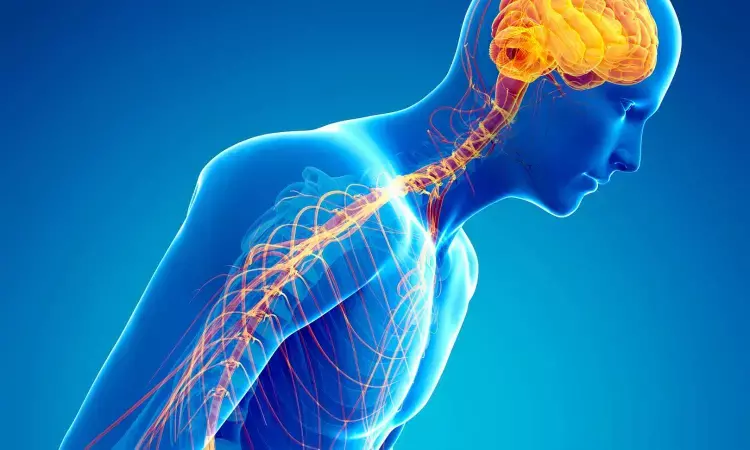- Home
- Medical news & Guidelines
- Anesthesiology
- Cardiology and CTVS
- Critical Care
- Dentistry
- Dermatology
- Diabetes and Endocrinology
- ENT
- Gastroenterology
- Medicine
- Nephrology
- Neurology
- Obstretics-Gynaecology
- Oncology
- Ophthalmology
- Orthopaedics
- Pediatrics-Neonatology
- Psychiatry
- Pulmonology
- Radiology
- Surgery
- Urology
- Laboratory Medicine
- Diet
- Nursing
- Paramedical
- Physiotherapy
- Health news
- Fact Check
- Bone Health Fact Check
- Brain Health Fact Check
- Cancer Related Fact Check
- Child Care Fact Check
- Dental and oral health fact check
- Diabetes and metabolic health fact check
- Diet and Nutrition Fact Check
- Eye and ENT Care Fact Check
- Fitness fact check
- Gut health fact check
- Heart health fact check
- Kidney health fact check
- Medical education fact check
- Men's health fact check
- Respiratory fact check
- Skin and hair care fact check
- Vaccine and Immunization fact check
- Women's health fact check
- AYUSH
- State News
- Andaman and Nicobar Islands
- Andhra Pradesh
- Arunachal Pradesh
- Assam
- Bihar
- Chandigarh
- Chattisgarh
- Dadra and Nagar Haveli
- Daman and Diu
- Delhi
- Goa
- Gujarat
- Haryana
- Himachal Pradesh
- Jammu & Kashmir
- Jharkhand
- Karnataka
- Kerala
- Ladakh
- Lakshadweep
- Madhya Pradesh
- Maharashtra
- Manipur
- Meghalaya
- Mizoram
- Nagaland
- Odisha
- Puducherry
- Punjab
- Rajasthan
- Sikkim
- Tamil Nadu
- Telangana
- Tripura
- Uttar Pradesh
- Uttrakhand
- West Bengal
- Medical Education
- Industry
Recognition and prevention of spinal cord damage in cases of nitrous oxide abuse: New Guideline

UK: Based on their experience in East London, an area of high N2O use, a research team from the UK provides practical advice on its recognition, investigation and treatment. The recommendations were published in the BMJ journal Practical Neurology.
Key points
• Serum B12 is often normal in N2O-SACD; functional B12 testing with methylmalonic acid or homocysteine can help to establish the diagnosis.
• Intramuscular B12 injection is a low-risk, high-impact treatment and should be given promptly once N2O-SACD is suspected.
• B12 injections should continue until improvement reaches a plateau; abstinence from N2O is crucial to recovery and allows B12 injections to work.
• Successful treatment of this condition requires a clear and smooth set of connections between the emergency department, ambulatory care and outpatient neurology.
Recommendations from research published today on the diagnosis and treatment of spinal cord damage caused by nitrous oxide abuse have been simultaneously adopted as official clinical practice guidelines by the Association of British Neurologists. The unprecedented speed in translating research into practice is necessary as medical cases of nitrous oxide abuse surge with increased use of what is now the second most popular recreational drug among young people in the UK.
Recreational use of nitrous oxide (N2O - also known as laughing gas) can lead to subacute combined spinal cord degeneration (N2O-SACD). This condition can cause serious and permanent disability in young people. While it may be treated effectively if recognised early, it is commonly misdiagnosed and inappropriately treated. No agreed treatment guidelines have previously existed.
The new research is based on a project to improve the diagnosis and treatment of N2O-SACD at the Royal London Hospital, where a new case presents once a week. Most patients present with an inability to walk, falls, and tingling or loss of sensation in their feet and hands. Other symptoms included weakness and bladder or bowel urgency or incontinence. Patients often do not mention nitrous oxide use, possibly because they do not connect it with their symptoms or because they feel there is a stigma associated with disclosing its use. Authors suggest that clinicians should be aware of the prevalence of nitrous oxide abuse in their local area and make careful enquiries to determine whether nitrous oxide abuse may be causing the symptoms.
Senior author Alastair Noyce, Professor in Neurology and Neuroepidemiology at Queen Mary and Consultant Neurologist, said:
“We developed these practical guidelines to try to standardise care for patients who have come to harm from recreational nitrous oxide use. If implemented correctly, they will ensure that patients get the treatment they need. We hope they will also alleviate pressure on hospitals by improving efficiency in the emergency department and reducing unnecessary admissions.”
Professor Tom Warner, President of the Association of British Neurologists, said:
“Recreational use of nitrous oxide carries a significant risk of damage to the nervous system, particularly the spinal cord, which is treatable if picked up. These important clinical practice guidelines lay out how to recognise, diagnose and, most importantly, treat those people attending emergency departments with such symptoms, and prevent long-term neurological disability.”
Reference:
Alvar Paris, Luke Lake, Albert Joseph, Anna Workman, Joseph Walton, Tom Hayton, Nikos Evangelou, James B Lilleker, Ruth M Ayling, David Nicholl, Alastair J Noyce. Nitrous oxide-induced subacute combined degeneration of the cord: diagnosis and treatment. Pract Neurol Epub ahead of print: 23 Feb 2023. doi:10.1136/pn-2022-003631
Dr Kamal Kant Kohli-MBBS, DTCD- a chest specialist with more than 30 years of practice and a flair for writing clinical articles, Dr Kamal Kant Kohli joined Medical Dialogues as a Chief Editor of Medical News. Besides writing articles, as an editor, he proofreads and verifies all the medical content published on Medical Dialogues including those coming from journals, studies,medical conferences,guidelines etc. Email: drkohli@medicaldialogues.in. Contact no. 011-43720751


